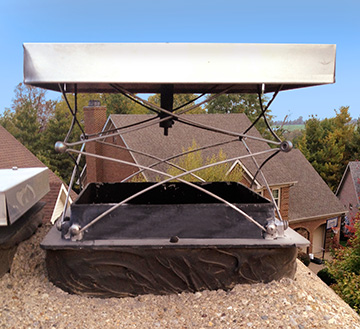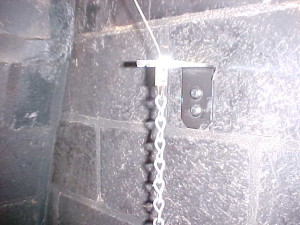You’re likely familiar with your fireplace damper. Each time you light a fire, you pull the lever or chain to allow the smoke from your fire to exit through your chimney. Perhaps you’ve felt the chilly draft that comes when you forget to close the damper again when you don’t have a fire burning.
 Your fireplace damper serves one main purpose: When your fire isn’t burning, it’s meant to prevent cold air from drafting back into your home. You probably don’t give much thought to your damper beyond that, but dampers can affect your home energy costs, with up to 8 percent of your home’s heat being lost up your chimney. Additionally, dampers can wear down over time, meaning you will need to know your options for damper repair and replacement. So what types of chimney dampers are there?
Your fireplace damper serves one main purpose: When your fire isn’t burning, it’s meant to prevent cold air from drafting back into your home. You probably don’t give much thought to your damper beyond that, but dampers can affect your home energy costs, with up to 8 percent of your home’s heat being lost up your chimney. Additionally, dampers can wear down over time, meaning you will need to know your options for damper repair and replacement. So what types of chimney dampers are there?
Throat dampers
Many chimneys are outfitted with traditional throat dampers. A throat damper is a metal flap and track — picture a trap door — affixed to throat of your chimney. That’s just above your firebox and just below the smoke chamber, the bottommost portion of the chimney. Most often, that flap is controlled either by a lever that can have a variety of motion, pushed up and down, from side to side, or in and out. With a rotary chimney damper, that flap can be controlled by a knob that, when turned, activates a gear system to raise and lower the damper. That means, with a rotary damper, you can control how far open your damper is.
Throat dampers can raise two problems because of their metal construction. First, they do not provide a tight seal, meaning they still allow cold air to penetrate your home when a fire isn’t burning in the fireplace. Second, as they are subject to the extreme heat of your fireplace and potentially water dripping down your chimney’s walls, throat dampers can warp over time, no longer forming a complete barrier between your fireplace and chimney.

Top-sealing dampers
Top-sealing dampers sit atop, rather than within, your chimney. The dampers are controlled by a stainless steel cable threaded through the chimney. A gasket allows the damper to seal completely, keeping cold air from flowing down your chimney and preventing warm air from escaping your home. The tight seal also prevents any water, animals or debris from entering your chimney.
Because of the ease of installation and the energy-efficiency benefits, top-sealing dampers often are installed when an existing throat damper fails and must be replaced. However, some homeowners choose to install top-sealing dampers even when their throat dampers are in good repair just due to the energy-saving benefits.
Remember to check your chimney damper!
If you feel a constant draft of cold in your home, or if your damper has become difficult to open and close, it could be time for repair or replacement. Our experts can evaluate your chimney damper and help you select a new damper, if needed.



